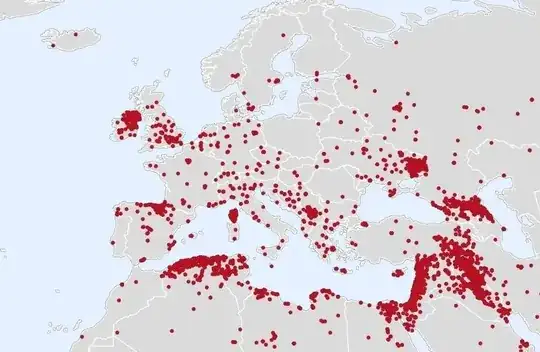tl;dr: The map is likely correct and based on the GTD from 2001 to 2014. As the map is not about Islamic terrorist attacks, but all terrorist attacks, no conclusion about Islamic attacks or refugees can be drawn from it.
Source of the Map
It is very likely that this map uses the Global Terrorism Database as a source, likely from 2001 to 2014, and there is no reason to doubt its accuracy.
The two dots in Iceland are the two terrorist attacks in Akureyri and Reykjavik in 2012 and 2014.
The dot in Portugal represents a terrorist attack in Lisbon in 2011. Note that this was not an Islamic attack, but an Anarchist attack.
We can assume that the map shows attacks after 2001, because before then, there are recorded terrorist attacks in Poland. This is the earliest occurance of the map that I could find, which mentions 2001.
We can also assume that the map is from before 2015, as the high number of attacks in Finland are not included.
A similar map can be seen here which visualizes the GTD data from 2011 to 2014.
The GTD also provides their own map, but it's for a 40 year span. Still, it shows a similar tendency as the map from the OP.
Quality of the map
Note that the map from the OP displays attacks as dots, which is a poor representation for what the map wants to express.
In countries in which terrorist attacks are concentrated on a specific location, it makes it appear as if there was less terrorism than there actually was, and for countries were terrorist attacks are spread out, it leads to the opposite effect.
The heatmap from the GTD linked above better visualizes the concentration of terrorist attacks.
About the GTD
Note that the definition of terrorism by the GTD does not just include major attacks or attacks with multiple fatalities. It also is not limited to a specific motivation (Islamic for example):
- Criterion I: The act must be aimed at attaining a political, economic, religious, or social goal.
- Criterion II: There must be evidence of an intention to coerce, intimidate, or convey some other message to a larger audience (or
audiences) than the immediate victims.
- Criterion III: The action must be outside the context of legitimate warfare activities.
Conclusions to draw from the map
We can't draw the conclusions proposed in the OP from this map for various reasons, among them:
- It is a map of all terrorist attacks, not just of terrorist attacks committed by refugees, and also not just Islamic attacks. This can easily be seen by the high amount of attacks in Ireland and Spain (specifically Basque Country), as well as the anarchist attack in Portugal. A considerable number of the attacks (even worldwide) in the GTD are non-Islamic.
- Even if we were to accept the map as showing attacks by refugees - which it does not - the map does not match the data of refugees by country (see also here; note the relatively high number of refugees in Sweden in 2014, and compare it to the very low number of refugees in Spain).
